
by Mary Howard
On 3/2/23, we were honored to welcome Katie Kelly and Lester Laminack to #G2great chat to take a closer look at their amazing new book with co author Vivian Vasquez: “Critical Comprehension: Lessons for Guiding Students to Deeper Meaning (2023, Corwin). Katie and Lester were also #G2Great guests on 3/21/19 for Reading to Make a Difference: Using Literature to Help Students Speak Freely, Think Deeply, and Take Action (2019, Heinemann). As I thought about both books, I noticed that they merge complementary ideas as Critical Comprehension supports and extends those ideas to an additional layer of understanding.
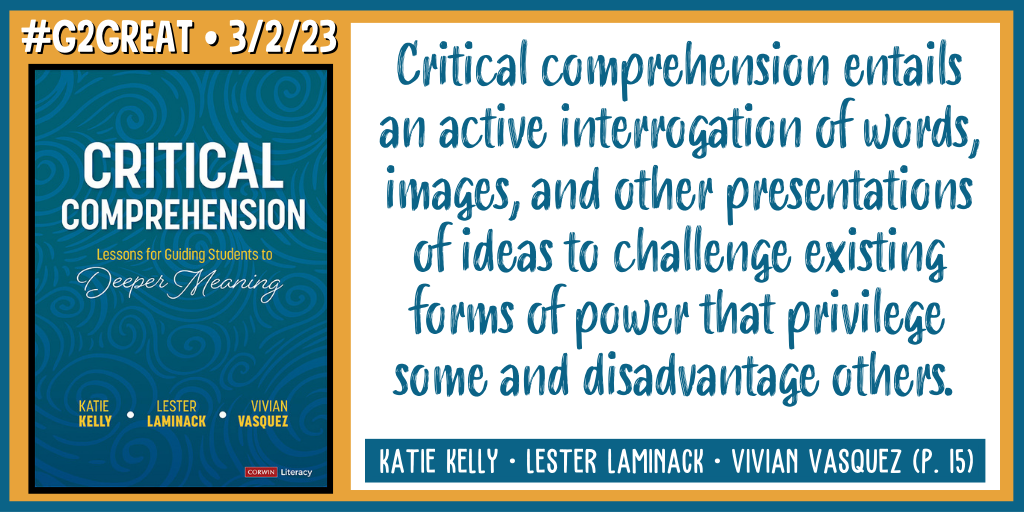
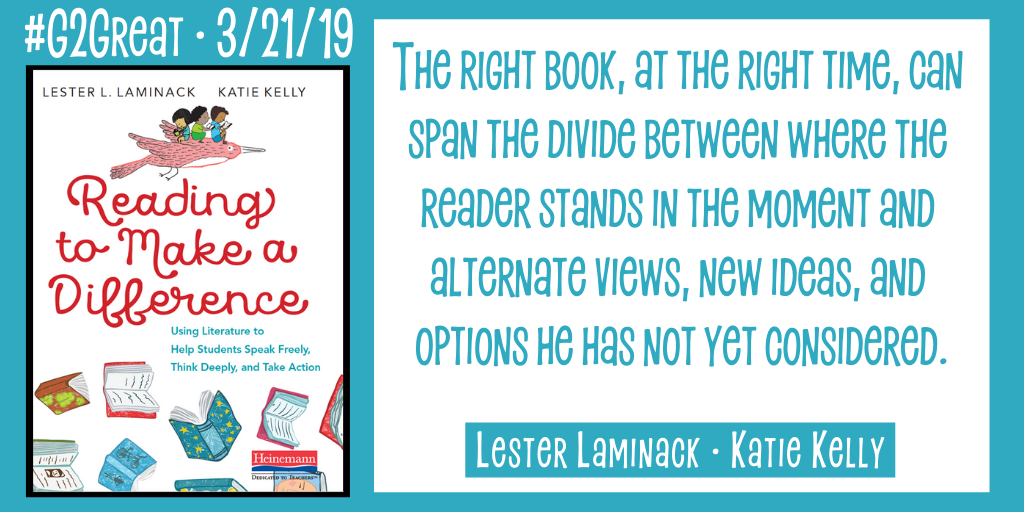
I am so grateful to write our post this week. Critical Comprehension reflects an essential and timely topic that the authors bring to life with tremendous depth of knowledge and actionable steps that teachers can take to begin or continue their journey toward these rich ideas. Given the current outside push and pull of key learning that resides within the pages of Critical Comprehension, this book is desperately needed in our schools and professional learning will be escalated by the conversations that it will surely inspire.
Before we dig into their book, let’s pause to view the author’s BOOK WHY in their words:
1) What motivated you to write this book? What impact did you hope that it would have in the professional world?
Our goal in writing this book is to offer opportunities for children to think beyond what is presented in a single text, as a single truth to seek counternarratives that can help them construct a more nuanced, complicated, and informed, understanding. When we teach children to be critical readers—to question the commonplace, to evaluate text for stereotyping and tokenism, to disrupt biases, and to seek counternarratives—they begin to weave threads to create more complete tapestries of truth.
In this post, my reflections will be through two Critical Comprehension lens from the authors as I draw both from their book and their twitter messages across our #G2Great chat. To do this, I’ll pull from several questions the authors crafted for the chat as a springboard to thinking and end each question with my thoughts. Then at the close of this post, I’ll share some tweets from those wise educators who attended our chat for yet one more thinking angle.
Let’s begin with two early questions that set the stage for this conversation:
(Q2) What comes to mind when you see the word “comprehension”?
FROM THE BOOK
Often the best way to think about what something is, is to begin by pondering what it IS NOT. Looking at comprehension from this perspective first can give us a pathway to explore the kind of comprehension that will lead to what the authors eloquently and clearly embrace in Critical Comprehension.
We remember reading in school as a task assigned by the teacher rather than meaningful, purposeful, or critical practice. Reading was often followed by a set of questions to answer, a book report, or some sort of written task. (P. 8)
Of course, knowing what comprehension IS NOT won’t necessarily lead us to think about what comprehension IS. But if we pull directly from the quote above and combine two words in the Critical Comprehension subtitle, then we have a thoughtful view of what comprehension IS: “meaningful, purposeful, critical practice” for “Guiding Students to Deeper Meaning.”
The tweet below between Katie and Lester illustrates what comprehension IS NOT followed by what comprehension IS in the next two tweets.
FROM THE CHAT
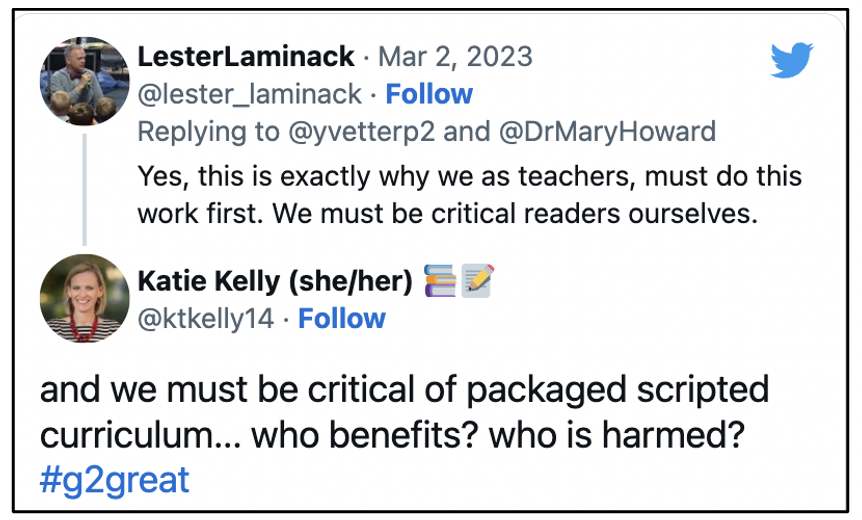
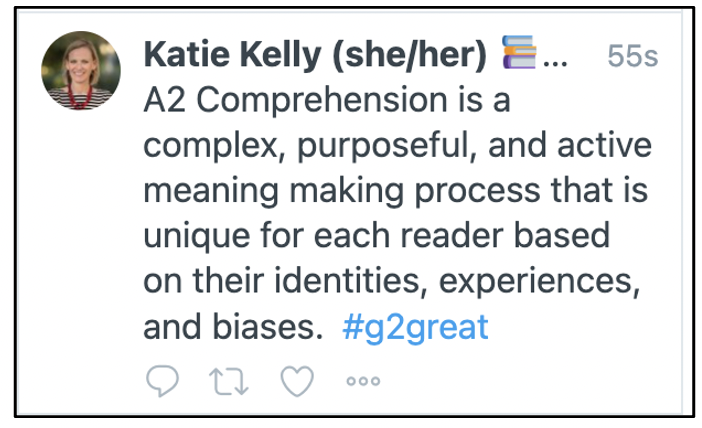
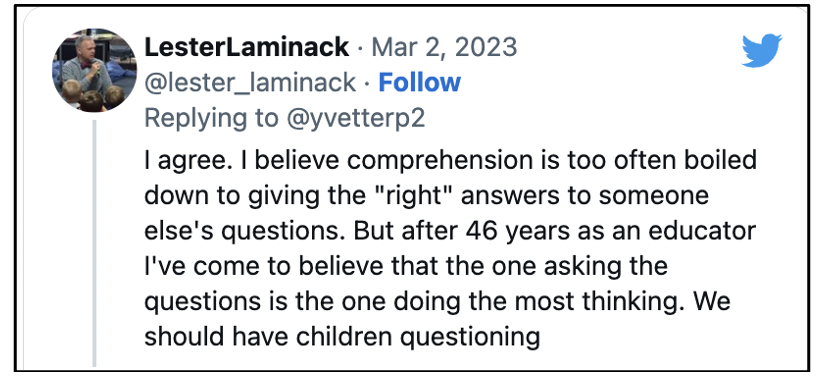
MY THOUGHTS…
As I look at the double lens IS/IS NOT view above, it occurs to me that we cannot elevate comprehension and the deep meaning that we want students to engage in unless we turn our thoughts INWARD. This requires us to contemplate how to set the stage for depth of thinking. This is not about the “right” answer but a “complex, purposeful, and active meaning making process” Katie describes. Lester reminds us of the impact that comes when we invite students to generate their own questions that inspire and fuel conversations that follow. Beginning by thinking about comprehension makes sense as comprehension and Critical Comprehension are inseparably connected and interrelated.
(Q3) What does critical comprehension mean to you?
FROM THE BOOK
Katie, Lester and Vivian beautifully reflect on the heart of Critical Comprehension using their collective WHY stated in their book:
“Our goal in writing this book is to offer opportunities for children to think beyond what is presented in a single text, as a single truth to seek counternarratives that can help them construct a more nuanced, complicated, informed, and accurate truth.” (page 12)
They follow with the words below that gives us a clear from-the-book meaning.
Critical comprehension, then, is an approach to deeper reading that moves beyond the passive acceptance of text and literal levels of meaning to question the word and the world (page 17)
FROM THE CHAT
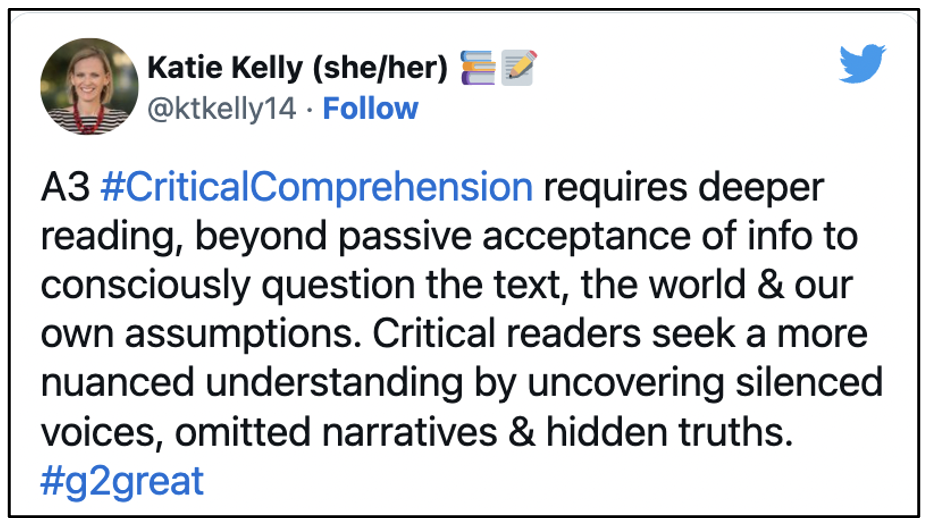
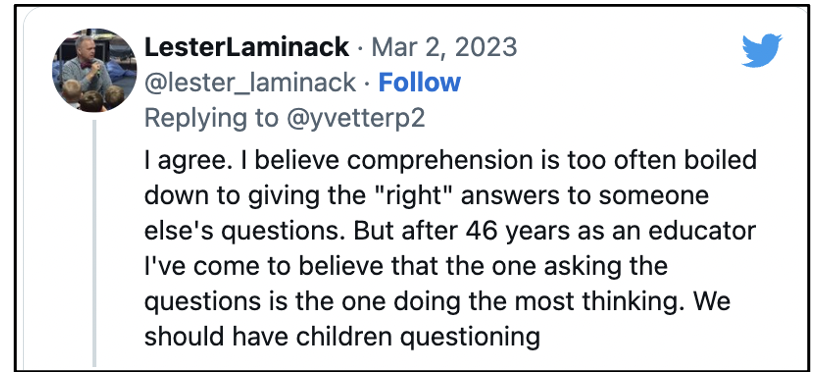
MY THOUGHTS…
In order to support students in a process that is inherent in those two words combined – Critical + Comprehension, we must also pay close attention to a tipping point of Critical Comprehension. How do we create an atmosphere where deep understanding and active engagement in this deeper thinking process is possible. This is where we ensure that all voices and perspectives are considered but also how we can turn this into social action that will take on a life of its own both within and beyond the text.
With our question starting point that combines comprehension and critical comprehension, let’s extend understanding using the authors’ final questions:
Q4 How does a study of perspective and bias inform critical comprehension? What are the benefits for students and society?
FROM THE BOOK
The authors gives us this beautiful explanation of perspective:
We think of perspective as the eyes, ears, heart, mind, and mouth of the story. Whose eyes are we seeing through? Whose ears are we hearing with? Whose heart is feeling and experiencing the emotions? Whose mind is making sense of events and offering us thoughts? Whose mouth is speaking all this to us and other characters? (page 77)
They follow this quote with words that beg for our close attention and are essential to Critical Comprehension:
Perspective is also whose eyes we are not seeing through. Whose ears we are not listening with? Whose feelings are not considered? Whose ideas are not included? Whose voices are silenced?
Although perspective and bias are addressed in two chapters in the book (perspective chapter 2); (Bias chapter 4), the authors expertly merge both in this question with Katie reflection on bias and Lester’s on perspective.
FROM THE CHAT
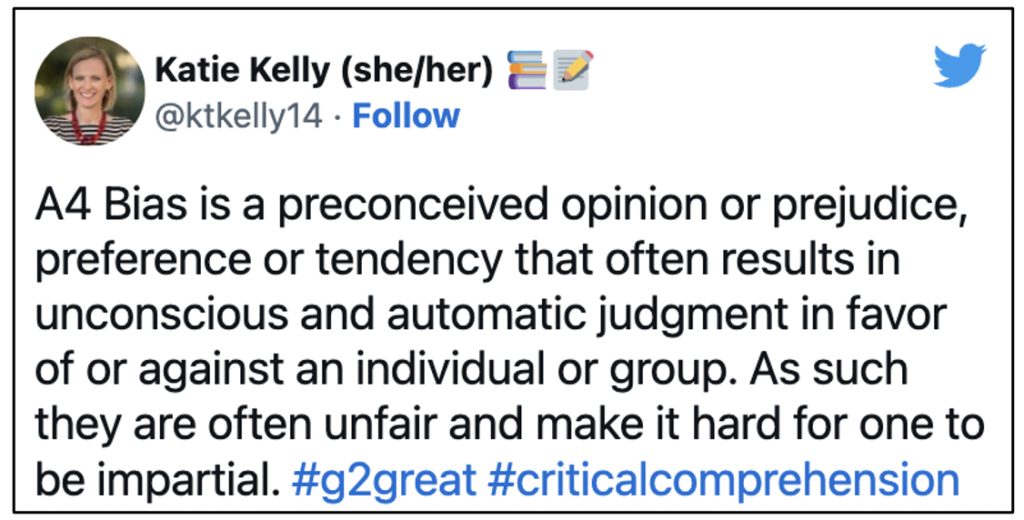

MY THOUGHTS…
Lester reminds us that perspective is a choice that the writer makes. This is also a reminder that how we view those writerly choices puts a choice in our hands as well. This asks us to do so considering perspective (and yes, bias) that we bring to the reading experience. The authors remind us that “We are all biased (yes, even you)” on page 152. This helps us acknowledge a hard reality that is an essential part of the Critical Comprehension process.
Q5 How do you lead students to question texts or authorities in a time when many adults are pushing for tighter control of access to books?
I’m going to switch this one up a bit by drawing from the book itself as well as a post about the book shared by Lester and Kelly on their Reading to Make a Difference Facebook page just before Critical Comprehension was published. The two sides together make perfect sense as I reflect on this question.
FROM THE BOOK
We shared the quote below in our #G2Great chat that speaks to this question:
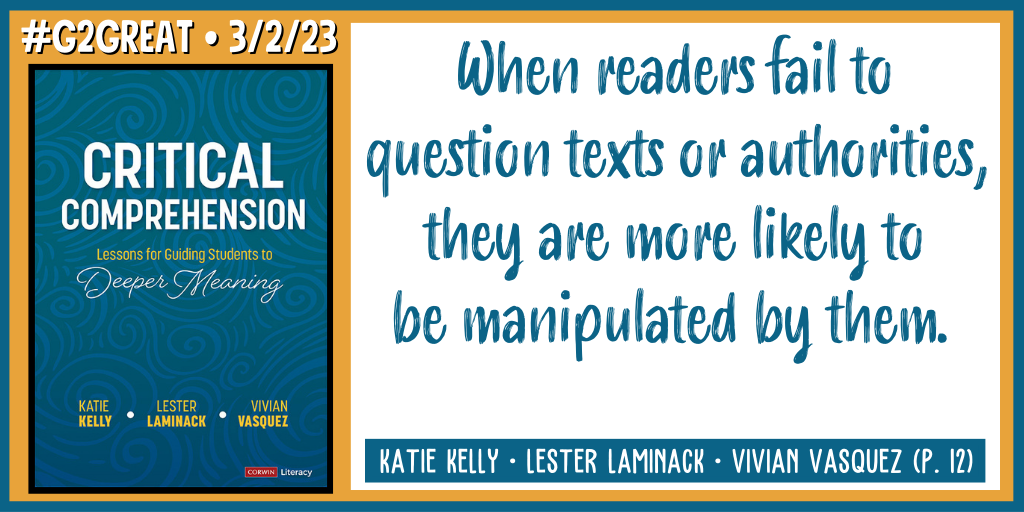
The post Lester and Katie share on Facebook is a reminder of the kind of things that we do as we ‘lead students to question texts or authorities’. If you have not joined this page, I highly recommend it Reading to Make a Difference Facebook
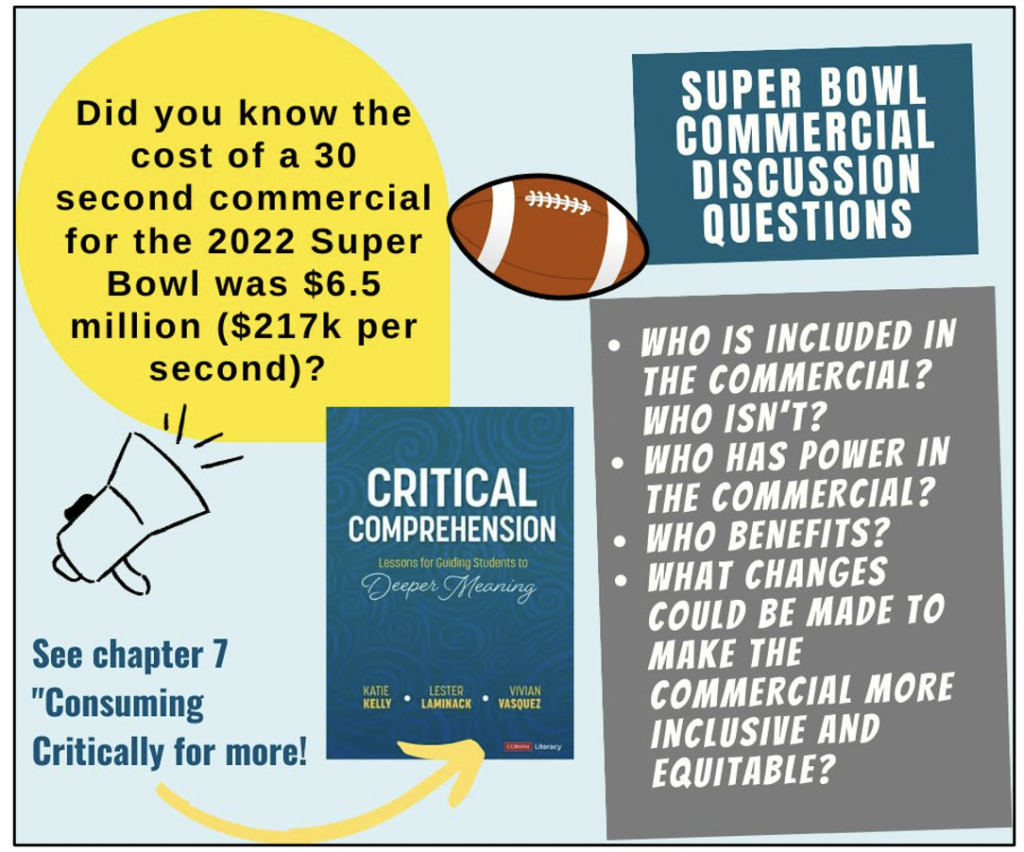
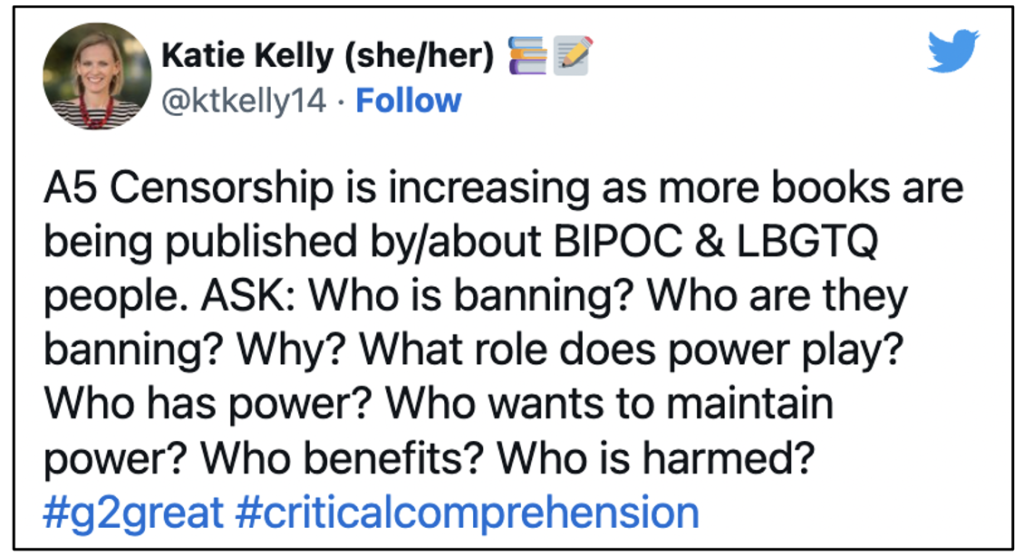
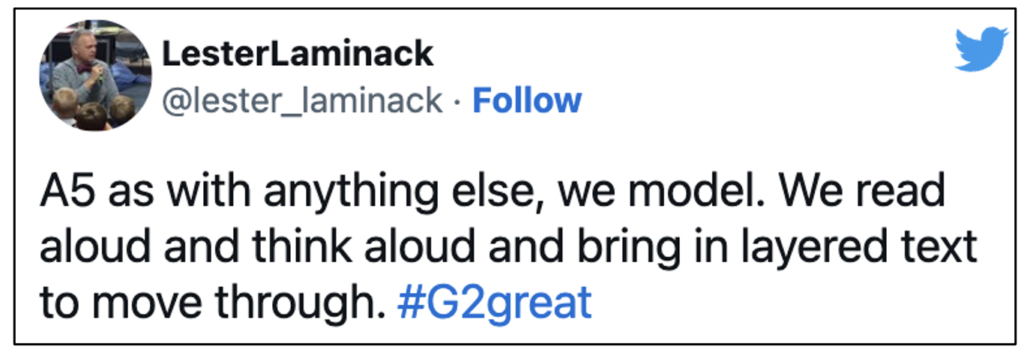
MY THOUGHTS…
Once again, the authors highlight key idea. Book banning has reached an all-time high that we could never have imagined. Katie poses thoughtful questions we can keep at the center as this reality rears its ugly head in our schools. Lester reminds us to model as we make kids privy to our thinking as a platform for engaged discussion. I shared their Facebook sample since I can’t think of a better way to begin these conversations than through real life examples like the Super Bowl. Imagine using images, video, magazines and other references that children connect to personally to initiate these conversations and then moving into texts. This brilliant shift in direction can support and extend their thinking.
Q6 How might you create spaces for critical comprehension in your setting/classroom?
FROM THE BOOK
This final author question is a perfect way to close our chat and this reflection. Katie, Lester and Vivian explain in their introduction how they create spaces (and I would argue professional inspiration) for critical conversations using “CRITICAL QUESTIONS For Thinking Beyond a Single Text:
“Engaging in conversations based on questions like these results in a shift away from the passive acceptance of, and search for, “the” correct meaning and is the basis of what we refer to as critical comprehension. (p.13)
FROM THE CHAT
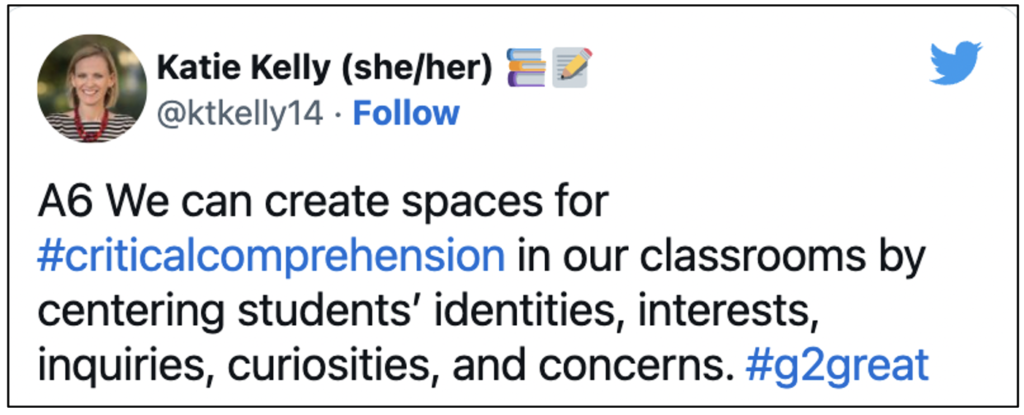
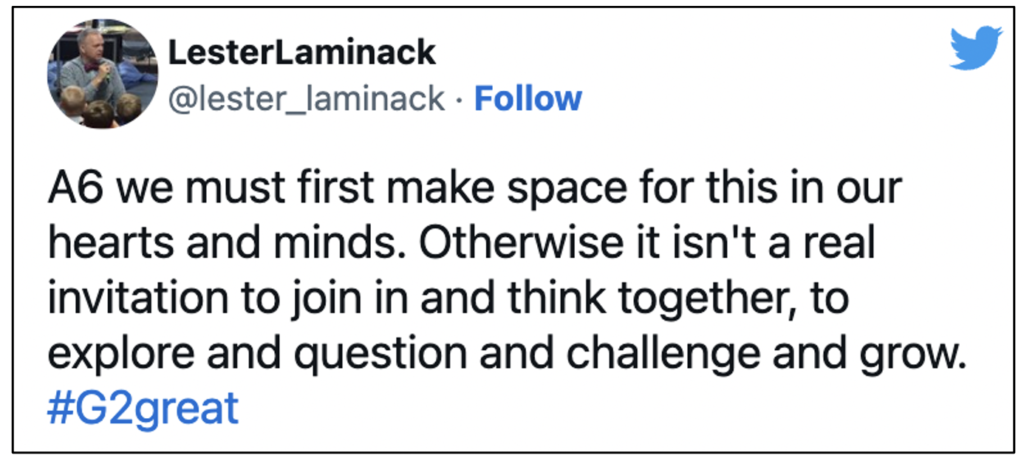
MY THOUGHTS…
Simply knowing what our students need does not necessarily translate to establishing priorities that will afford us the time, energy and space we need to put those things into action where it matters most. Katie, Lester and Vivian have graciously written a book that responds directly to this question. Critical Conversations offers a professional playground with chapters that provide a myriad of lessons so that teachers can take action immediately as you can see below. This is further supported in “Reading for Action” at the end of each chapter with ideas and suggestions to use after reading a collection of texts.

In the conclusion to their book called YOUR TURN, they give us wise advice with a call to action (pages 247-257).
Before I share my closing thoughts, let’s turn back to our authors as they reflect on another question:
2) What are your BIG takeaways from your book that you hope teachers will embrace in their teaching practices?
We hope teachers will push themselves to think more critically as readers, so they can help students shift from passive acceptance of information towards deeper meaning through critical comprehension.
One way teachers can do this work is by engaging students in critical conversations using discussion questions such as:
How does this text position the reader?
Who is included or excluded in the text?
What are potential counter-narratives for the text?
MY CLOSING THOUGHTS
As I come to the end of this post, I’m draw to Critical Comprehension and the gift the authors have given us. It would be hard for anyone to argue that what we say we value is reflected by our willingness to put those values into action. If we are unwilling to do that, then it is our values that maybe be in question.
Across the pages of Critical Comprehension, the authors leave nothing to chance to ensure that teachers will not just read this book and walk away but follow the reading by bringing it to life in glorious living color action in the company of children. I believe that this book and the support they have so generously given us in the book as well through our #G2Great twitter chat makes it impossible not to breathe life into the book and bring that learning into our classrooms.
This book has never been more needed as we stand at the precipice of change from all sides that are closing doors to the critical conversations described in this book and replacing them with obligatory by-the-book and the laws of the district and even state Katie, Lester and Vivian speak to so eloquently. We are given the information we need, but we are also given also a vision for what this could look like in a classroom with examples at varied grades to draw from including downloadable examples. As professional they offer the support we ned so that we will “read with the text as well as critically against the text (p. 26)
In closing, Katie, Lester, and Vivian write in their introduction the words that I carried with me across this book and into the chat.
We are currently a part of history, and we have the power to shape it. (p. 7)
We are so grateful to Katie, Lester and Vivian for writing this remarkable book and giving us what we need to use our power to shape history. The question then begs us to ask a question in closing:
“WILL WE?”
I’ll give the author’s the final word with their reflection to our final question:
3) What is a message from the heart you would like for every teacher to keep in mind?
Our message to educators is a call to action. If we plan to leave a better world for the next generation, it is our responsibility to take action. The decisions we make every day about what we include (and exclude), whose voices and stories are centered (and silenced or ignored), and the way we create space for critical awareness and curiosity can be transformative. Reading for critical comprehension positions us with the power to make informed decisions. Only then can we advocate for equity and justice. We need information to take action and be part of the change. This work begins with each of us as teachers and our students.
WORDS OF WISDOM FROM OUR #G2Great Chat Friends
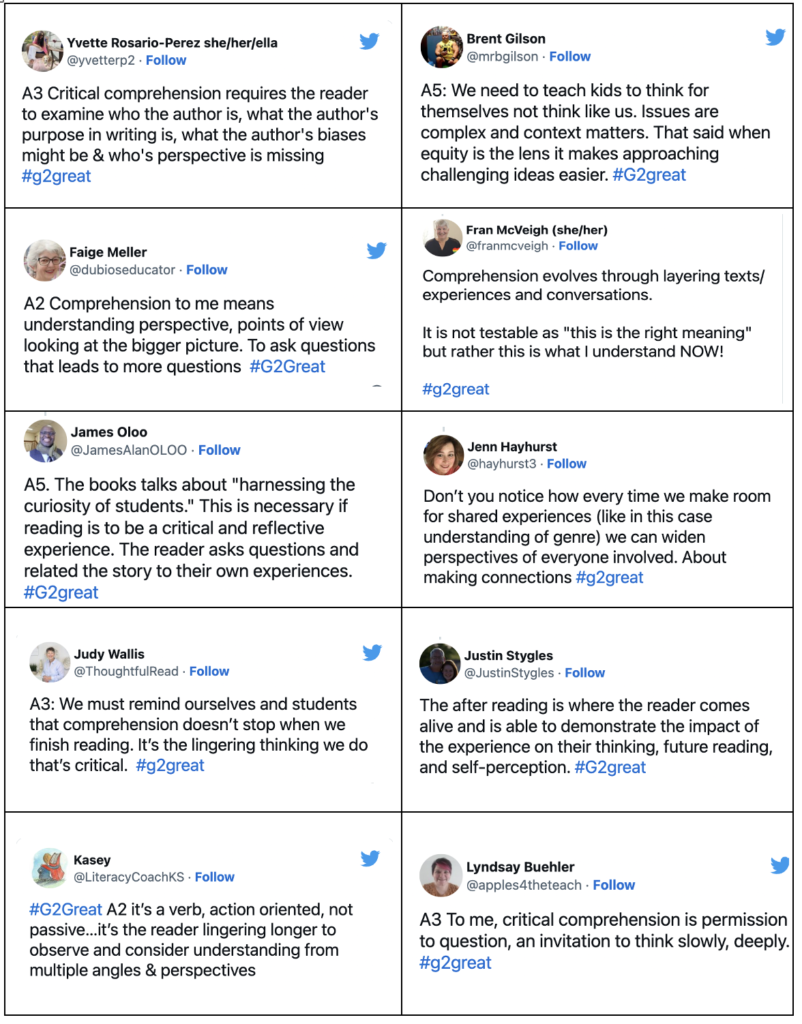
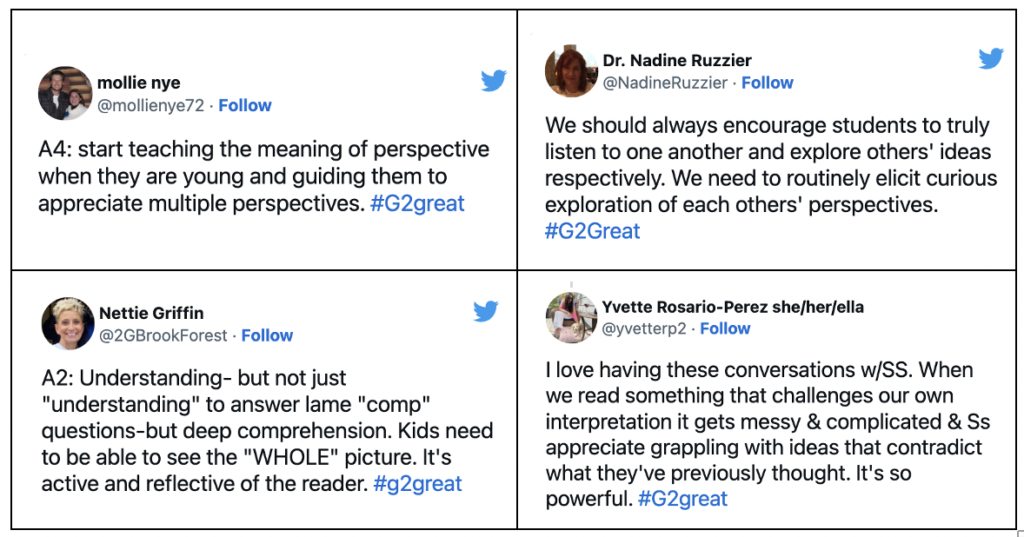
LINKS
Critical Comprehension: Lessons for Guiding Students to Deeper Meaning written by Katie Kelly, Lester Laminack, and Vivian Vasquez (2023, Corwin)
Reading to Make a Difference: Using Literature to Help Students Speak Freely, Think Deeply, and Take Action written by Lester Laminack and Katie Kelly (2019) Heinemann